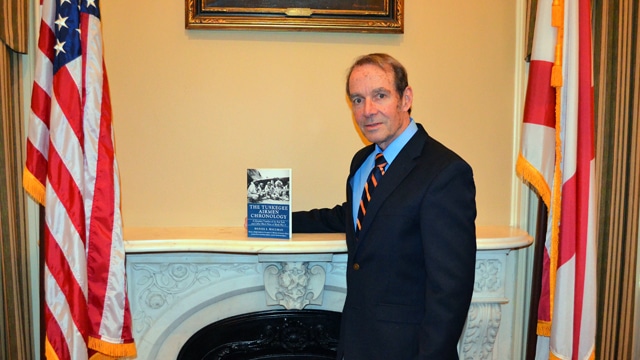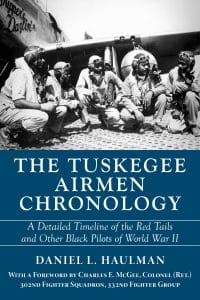New Tuskegee Airmen book sets the record straight

Portrait of Dr. Daniel Haulman posing with his new book, The Tuskegee Airmen Chronology: A Detailed Timeline of the Red Tails and Other Black Pilots of World War II. (Mike Tomberlin, AlabamaNewsCenter)
While many people believe they know the story of the Tuskegee Airmen, it is a narrative influenced by movies, misconceptions and myth. In his new book, “The Tuskegee Airmen Chronology: A Detailed Timeline of the Red Tails and Other Black Pilots of World War II,” Dr. Daniel Haulman, chief, Organizational Histories, at the U.S. Air Force Historical Research Agency, provides a thorough account that both engages and sets the record straight.

(NewSouth Books)
“The book provides a very detailed chronology with a timeline of events almost daily,” Haulman said. Through the comprehensive dates and details pulled from original, historic documents, Haulman dispels many of the misconceptions that have been a part of the Tuskegee Airmen narrative for decades.
For example, a common myth is that the Tuskegee airmen pilots never lost a bomber during escort missions for the Fifteenth Air Force.
“That was never true,” Haulman said. “Of the 179 bomber escort missions, they lost bombers on seven of those missions. … If you add up the total number of bombers that were shot down while under Tuskegee Airmen escort, you get 27. The average number lost by the other fighter groups in the Fifteenth Air Force was 46, so they lost significantly fewer bombers than the other fighter escort groups,” Haulman said.
“One reason why these myths developed was because the documents that would either prove or disprove the myths were classified at first, and it took a while for them to be declassified,” he said. “By the time they were, the myths were already in circulation.”
Daniel Haulman’s book sets the record straight on the Tuskegee Airmen from Alabama NewsCenter on Vimeo.
Haulman, a leading Tuskegee Airmen expert, began his research in 2006 by examining mission reports in the collection at the Air Force Historical Research Agency in Montgomery. During this early research, Haulman discovered that the Tuskegee Airmen had lost bombers while under escort – findings he shared at an academic conference that year.
His research and findings created a buzz in the history community. “As questions would come into the archives section of the agency (Air Force Historical Research Agency), they would refer them to me,” Haulman said. He decided to write the chronology so that everyone would have ready access to the facts and detailed information about the Tuskegee Airmen missions.
For Haulman, whose father was a B-24 pilot during World War II, the history and inspiring story of the Tuskegee Airmen energize his passion for research and publishing. “They fought two enemies, Nazis in Europe and racism at home, and through their dedication and effort earned a hard-won double victory.”
The U.S. military had aircraft and Army pilots in service in 1909, just six years after the Wright Brothers flew an airplane successfully. However, “they did not have black pilots in the American military until 1942 – that’s over 30 years, and racism was the main reason,” Haulman said.
In 1940, Franklin D. Roosevelt ran for an unprecedented third term as president. During his campaign, he promised to allow black men to train to be pilots in the military. “He fulfilled his promise in March 1941, when the 99th Pursuit Squadron was activated,” Haulman said.
Tuskegee was chosen as the training site because it was in a part of the country with better weather, for more good flying days. In addition, Tuskegee Institute was one of six black institutions of higher education that had a civilian pilot training program.
“The Tuskegee Institute lobbied for the training facility and received the contract for the primary flying school,” Haulman said. Since it was the only place for black pilots to receive military training, they received cadets and pilots from around the world.
Not long after the end of World War II, the Air Force moved toward integration. “President (Harry) Truman’s Executive Order 9981 mandated the integration of all military services, partly because of what the Tuskegee Airmen had done,” Haulman said.
In addition to verifying the dates and information about the famous Tuskegee fighter pilots and their missions, “The Tuskegee Airmen Chronology” also includes information about the support staff that were part of the Tuskegee Airmen.
“We think of the Red Tails and the pilots, but it’s a much more complex story than that,” said Haulman. “For every Tuskegee Airmen pilot there were at least 14 who were not pilots … including maintenance personnel on the ground, crew chiefs, intelligence officers, weather officers and female nurses.” Today, fewer than 20 of about 1,000 Tuskegee Airmen pilots are still living. The number of ground personnel, originally estimated to be about 14,000, is unknown.
In 2008, part of Moton Field, home of the Tuskegee Airmen’s primary flight training facility, opened as a visitor center and museum at Tuskegee Airmen National Historic Site. Today, the site contains a walking trail and several historic structures, and Hangars 1 and 2 have been converted into exhibition space to commemorate and share the story of the Tuskegee Airmen.
“The Tuskegee Airmen Chronology: A Detailed Timeline of the Red Tails and Other Black Pilots of World War II” is available in local or online booksellers or directly from NewSouth Books, 334-834-3556, http://www.newsouthbooks.com/.
Dr. Daniel L. Haulman is chief, Organizational Histories, at the U.S. Air Force Historical Research Agency. He has authored many books and scholarly articles about the airmen, including as co-author the bestselling work “The Tuskegee Airmen, An Illustrated History: 1939-1949,” published by NewSouth Books. As a member of the Tuskegee Airmen Inc. for many years, he has attended seven of the organization’s conventions and counts many Tuskegee Airmen as friends.














